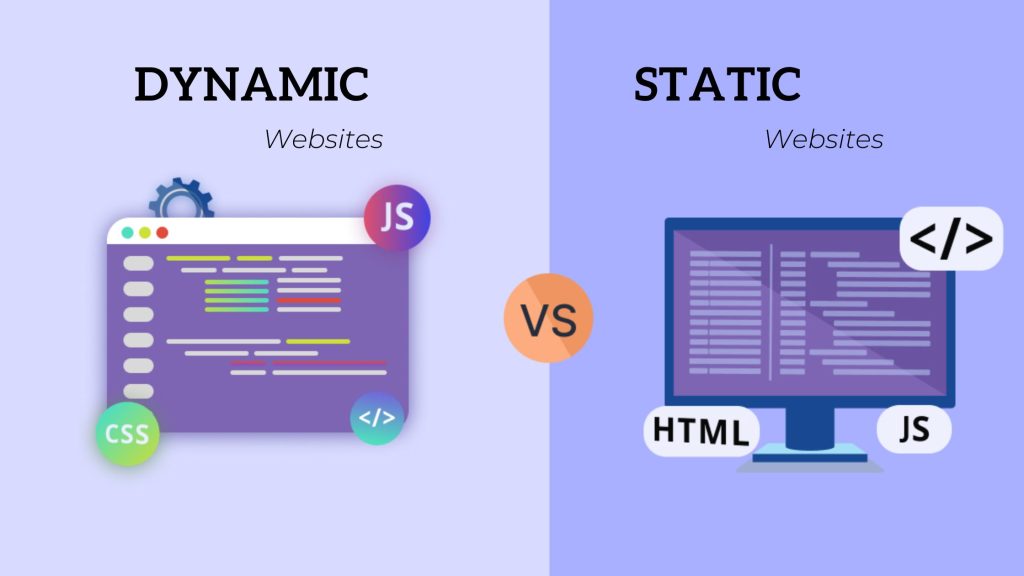In today’s digital age, having a website is crucial for any business or individual looking to establish an online presence. Websites serve as the primary point of interaction between a brand and its audience, influencing user engagement, conversions, and overall business success.
When it comes to website development, one of the most fundamental decisions is choosing between a static and a dynamic website. Each type has its advantages and limitations, making it essential to select the right one based on business needs and goals.
This blog will provide a detailed comparison of static and dynamic websites, discussing their functionality, benefits, limitations, SEO impact, and real-world applications. By the end, you’ll have a clear understanding of which website type suits your requirements best.
Understanding Static Websites
What is a Static Website?
A static website consists of fixed web pages built using HTML, CSS, and JavaScript. These pages do not change unless manually updated by a developer. Since they do not require server-side scripting or a database, static websites are simple and lightweight.
Advantages of Static Websites
- Faster Loading Speed: Since there are no database queries or dynamic content processing, static websites load much faster.
- Cost-Effective Development: Requires less time and effort to build, reducing development costs.
- Enhanced Security: No database means fewer security risks and vulnerabilities.
- Easy Hosting & Maintenance: Can be hosted on simple servers with minimal upkeep.
Limitations of Static Websites
- Not Suitable for Frequent Updates: Every content change requires manual editing, making updates time-consuming.
- Limited Functionality & Interactivity: Lacks user interaction features such as login systems, search functions, and content personalization.
Understanding Dynamic Websites
What is a Dynamic Website?
A dynamic website generates content in real time based on user interactions and database queries. It utilizes server-side scripting languages like PHP, Python, or JavaScript along with Content Management Systems (CMS) such as WordPress.
Advantages of Dynamic Websites
- Easy Content Updates & Management: Content can be updated without modifying the code, making it ideal for blogs and news websites.
- User Interaction & Personalization: Enables features like user logins, comments, and personalized recommendations.
- Scalable & Feature-Rich: Can accommodate complex functionalities such as e-commerce, forums, and automated content updates.
Limitations of Dynamic Websites
- Higher Development & Maintenance Costs: Requires backend programming and database management, increasing complexity.
- More Security Vulnerabilities: Due to database connections, dynamic websites are more susceptible to hacking.
- Requires More Server Resources: Can be slower compared to static sites, especially if not optimized properly.
Key Differences Between Static and Dynamic Websites
| Feature | Static Website | Dynamic Website |
| Technology | HTML, CSS, JavaScript | PHP, Python, JavaScript, CMS |
| Data Storage | No database | Uses a database |
| Content Updates | Manual | Automated |
| Interactivity | Limited | High |
| Cost | Low | High |
| Speed | Fast | Slower |
| Maintenance | Minimal | Ongoing maintenance |
Choosing between a static and dynamic website depends on business needs, budget, and required functionality.
Static vs. Dynamic Website SEO: Which is Better?
SEO Advantages of Static Websites
- Faster Page Loading: Google prioritizes speed, improving ranking potential.
- Fewer Security Risks: Better security can lead to improved trust signals.
SEO Advantages of Dynamic Websites
- Frequent Content Updates: Search engines favor regularly updated content.
- User Interaction & Personalization: Increased engagement can boost rankings.
Choosing the Right One for SEO
- If speed and security are top priorities, go for a static website.
- If content updates and user interaction are crucial, a dynamic website is better.
Examples of Static and Dynamic Websites
Examples of Static Websites
- Personal blogs with minimal updates.
- Small business landing pages showcasing services.
- Portfolio websites displaying work samples.
Examples of Dynamic Websites
- E-commerce platforms (Amazon, eBay) handling real-time transactions.
- Social media sites (Facebook, Instagram) with interactive user engagement.
- News websites (BBC, CNN) requiring frequent content updates.
Choosing the Right Website Type for Your Business
When to Choose a Static Website
- Small businesses with minimal updates.
- Portfolio or brochure-based websites.
- Projects requiring cost-effective solutions.
When to Choose a Dynamic Website
- Businesses requiring frequent content updates.
- E-commerce, membership sites, or blogs.
- Companies prioritizing user engagement.
Hybrid Approach: The Best of Both Worlds
Some businesses adopt a hybrid model, using static pages for essential content while employing a CMS for blogs and interactive elements.
Conclusion
Both static and dynamic websites have their advantages, and the right choice depends on your business needs, budget, and scalability requirements.
For startups and small businesses in Bangalore, static websites offer speed, security, and cost-effectiveness. Meanwhile, dynamic websites are ideal for growing enterprises and content-driven platforms that require flexibility and real-time updates.
If you’re looking for expert website development solutions in Bangalore, WebSenor is here to help. With years of experience in crafting high-performance websites, WebSenor ensures your business gets the perfect digital presence. Contact us today to get started!







